Are you interested in learning how to crochet 100 different colorful motifs — plus incorporating those new motifs into lovely projects such as a cozy blanket, a vibrant table runner, a modern rug and others? If so, Crochet Kaleidoscope: Shifting Shapes and Shades Across 100 Motifs is a book you’ll want to know about.
This book also includes helpful information about choosing colors for your motifs. Crochet Kaleidoscope is part crochet pattern book and part color theory text; the result is an inspiring journey into the world of what’s possible when crocheting motifs with color.
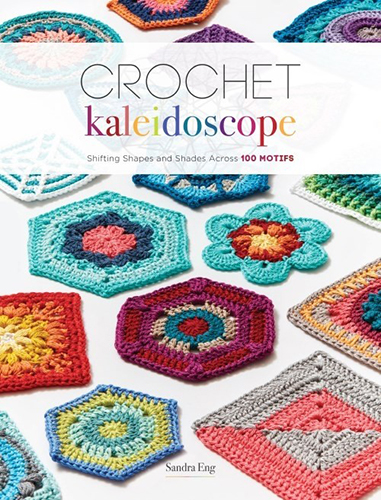
What You Need to Know About This Crochet Pattern Book:
Author: Sandra Eng
Publisher: Interweave Press
Copyright Date: January 31, 2018
ISBN 13: 978-1632506139
ISBN 10: 1632506130
Book Formats:
I am reviewing a paperback copy of the book, which is delightful. It’s a high-quality publication. The paper has a nice feel, and the book is substantial without being needlessly hefty. Thumbs up to this format!
Number of Pages: This book is 160 pages long.
Topics Covered in This Book:
- Learn how to crochet motifs including granny squares, hexagons, circles, medallions, triangles and flowers using symbol crochet charts and written text patterns.
- Learn how to choose compelling yarn color combinations for your crochet projects.
- Learn the secrets for how to put your colors in the right order for maximum visual appeal.
- Discover the basics of color theory: contrasting color palettes, analagous color palettes, gradient color palettes and more.
- The book also includes a helpful glossary and stitch key for enabling you to better understand all the symbol crochet charts and the terminology the book’s author used to explain the crochet motif patterns.
The Focus of This Book:
This book has two main focuses: color and crochet motif patterns. There are zillions of books on the topic of crochet motifs, but I’m not aware of another motif pattern book that has such a pronounced emphasis on color the way this one does. So if you want a new library of crochet motifs and you could use some color inspiration when you create your own projects, this is the book for you. All together, there are 100 different motif patterns plus 5 patterns for finished crochet projects in the book — plus all the above-mentioned information about how to select colors for your crochet projects.
Crochet Projects Included in This Book:
- 100 Different Crochet Motifs
- Vintage Crochet Bauble Blanket Pattern
- Women’s Mod Flower Crochet Shawl Pattern
- Zinnia Crochet Table Runner Pattern
- Solstice Crochet Pillow Pattern
- Circles in a Square Crochet Rug Pattern
More Crochet Project Ideas from Crochet Kaleidoscope
While I’m looking forward to hopefully working some of the projects Sandra designed, I haven’t got around to doing that yet — because I’ve been too busy working on all the ideas that have occurred to me as I look at the motifs included in the book. I’m finding this book to be one of the richest sources of crochet inspiration I’ve ever worked with. So far, I’ve made 6 projects from the book, and I have notes for making a few dozen more if I can find both time and suitable materials for doing so.
So far, my favorite project inspired by the book is this potholder:
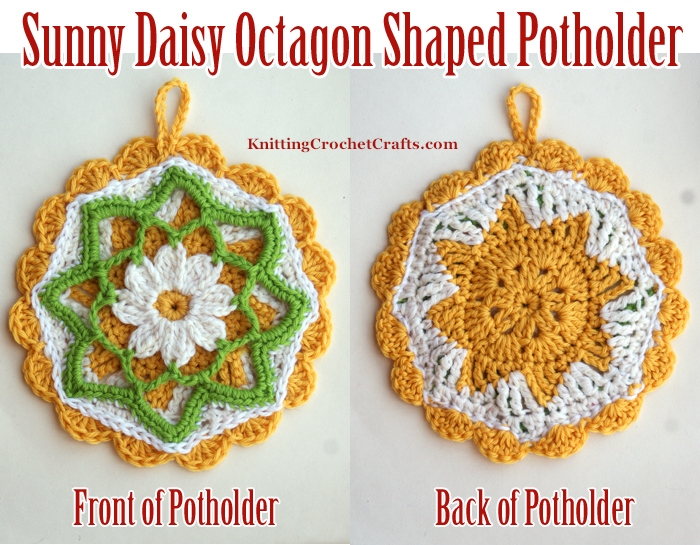
The front of the potholder incorporates motif #98 from Crochet Kaleidoscope; the back of the potholder is motif #97 from the book. I blocked both motifs to the same size. Then I pinned them together with the wrong sides facing and the points matching up. I whipstitched them together, then added a simple shell stitch edging and a hanging loop.
Many more of these are in my future; I think this is going to be my go-to design for future gift giving until everyone in my “inner circle” who appreciates froo-froo little lovelies like this owns a pair.
Crochet a Blizzard of Snowflakes
Looking at the colors Sandra has selected for presenting her hexagon patterns, I don’t think she intended the majority of them to look like snowflakes — but I do see snowflakes when I look at some of them. Motif #65 is a perfect example. This is a lovely, lacy hexagon motif that looks like it’s just dying to be used as a snowflake applique to adorn winter projects like blankets, scarves and sweaters.
Sandra chose 3 colors for this motif, and I think her color choices were stylish and spot on. Her original color selection was gray, dark indigo blue and a lovely light lavender color.
To make a three-color version of this motif look sufficiently snowy that it could pass for a snowflake, my first color choices would have been a pale, frosty aqua, a misty gray and bright white; but I don’t have those particular colors stashed at the moment. So I decided to just crochet the design using the one solid, frosty-looking pale blue yarn color I happened to have on hand. From this experiment, I discovered that it is just as beautiful being a one-color motif as it is being a tri-color design.
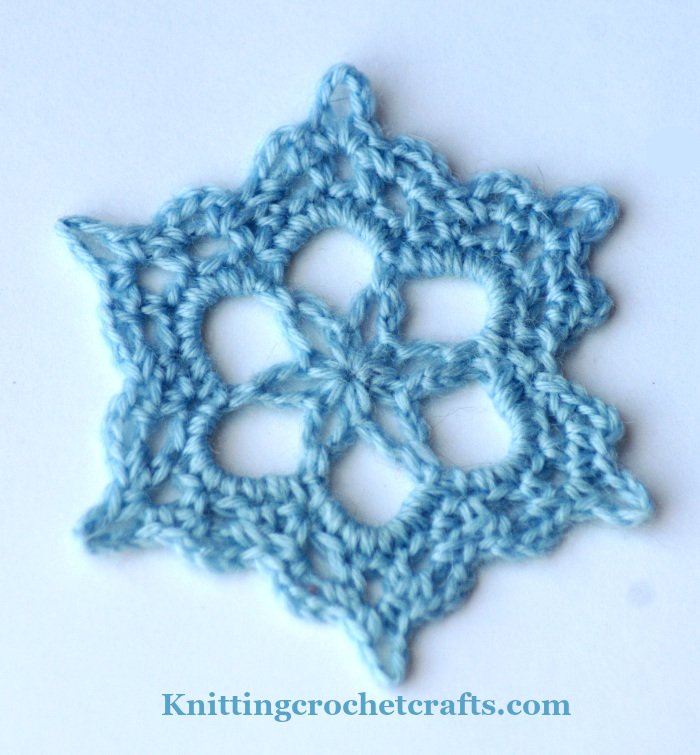
There are soooo many other ways you could work this hexagon. My head is exploding with different ideas. It’s a little mind boggling to think about all the possibilities. Next on my to do list, I want to try crocheting it with 3 colors of wire. I’m thinking that white, bright silver, and pewter would be one interesting color combination to try. It could also be interesting to add some sparky beads to the project if bead crochet appeals to you.
Crochet a Hexagon-Shaped Mint Candy Dishcloth
Sandra designed two colorways of a neat-o two-color hexagon motif. I simply love this design, and I imagine that many of you will also find it appealing. Her original colorways are pink with navy blue and black with white, both of which are really cool exactly as she designed them. But I look at this motif and see a swirly mint candy.
The Best Things About This Book
As you can probably tell from the projects I’ve posted so far, I’m finding this book incredibly inspiring. It’s motivating me to get a big chunk of my gift projects completed early this year — which is fantastic! I hope it will do the same for you.
Whether or not you’re interested in designing your own projects using crochet motifs, I think you’ll enjoy the finished projects Sandra has designed for you in Crochet Kaleidoscope. They’re unique without being outlandish; they’re also classic and appealing. Most crocheters are likely to agree they’re worth both the yarn and time investments. If you take the time to make these designs, you’re likely to get many years worth of use out of them.
There are lots of wonderful “extras” in this book: For example, there are extra colorways available for many (but not all) of the motif patterns. I counted 44 color variations all together. Many of the extra colorways are strikingly different from the first.
At the beginning of each section, there’s an extra group photo that shows you how the designs all look when laid out together. This allows you to get a feel for how motifs compare against each other, which is helpful if you want to incorporate several of them into the same project. It’s also helpful if you just want to get a quick visual idea of which of the motifs in the section turn out biggest or smallest, without having to invest the brainpower it would take to scrutinize all the patterns. These helpful “extras” give you a good reason to choose this book over competing titles that lack these details.
Finished sizes are noted for all the designs, which is an extremely helpful detail if you want to use several of the motifs together in the same project. Sandra has included quite a few motifs that are the same sizes. Many of these motifs could easily be used together in the same project.
The styling in a book can make or break the way crafters perceive the projects in it. Excellent projects + poor styling = a potential book failure, because some crafters will be unable to imagine the projects incorporated into their own homes, wardrobes and lifestyles.
That IS NOT an issue with this book. The styling approach in Crochet Kaleidoscope is exceptional. The stylist chose furnishings and accessories in mostly white and neutral colors that allow the colorful crocheted pieces to take center stage. In each photo, there’s enough of a background setting present to empower you to understand and imagine how the crochet project could potentially fit into your home and your lifestyle — but the furnishings do not distract from the projects. This is ideal for allowing you to figure out whether each piece would be one you want to make, or not.
The crisply detailed photography allows you to see the important details of each motif pattern. The presentation doesn’t put any undue burdens on your imagination or powers of deductive reasoning; everything is presented clearly.
You’ll have access to both symbol crochet charts and written instructions in this book, so you’re covered whichever way you prefer to work your crochet patterns.
The colorways presented in the book are fresh, original and intriguing — yet Sandra’s clearly-presented instructions have made it easy to recolor them all in the unlikely event you do not like her color choices (or if you just need to recolor them to match your own furnishings, wardrobe or color preferences — or a gift recipient’s).
The book was quite obviously formatted by an expert. It is laid out without either overcrowding or wasted space. The fonts are all appropriate and readable. The layout isn’t overly faddish, and the book is likely to still look classic and on-trend 10+ years in the future.
There’s enough incredible material here to keep you busy for years! I own bunches of different motif pattern books, and I love all of them — but this one is my new favorite. These motifs are all exceptionally well designed. Sandra’s color sense is really different from mine, and I’m finding it quite inspiring to study the way she’s put her colorways together.
Other Observations About This Book
Circles, Crochet Flowers or Octagons? Stars or Crochet Hexagons? Yes to All of the Above

Crochet Kaleidoscope is formatted in three main sections:
- The section about color, entitled “Color Me Creative”
- The section where the motif patterns are presented
- The section where the finished projects are presented.
In addition to these, there are also multiple helpful reference sections such as an introduction, stitch key, glossary and reference section.
The motif section of the book is further broken down to help you easily locate the circles, squares, hexagons, triangles and other shapes (other shapes = octagons, mostly).
I noticed something really intriguing when leafing through the pages of this book: It dawned on me how challenging it can be to classify some of the more unusually shaped crochet motifs like the ones included in Crochet Kaleidoscope. If you had left it to me to classify the motifs in this book, I probably would have made additional sections for “flowers”, “stars” and “snowflakes”, although admittedly, these would have ended up being small sections. Here these types of motifs are sort of lumped in with the circles and hexagons, which, for the sake of simplicity is totally understandable.
BUT, as far as this book’s main selling points go, I think it is important to draw attention to the fact that this book does contain multiple gorgeous motifs that resemble flowers, stars and snowflakes. In particular, huge numbers of my readers are interested in crocheting flowers — so it would be a disservice to everyone if I were to neglect to mention that some of the circles, hexagons and octagons included in this book could also be classified as “crochet flowers”. In my experience, there’s much more interest in crochet flowers than there is in crochet triangles, and I definitely DO NOT want you to come away from reading this review with the impression that there are triangle motifs in this book but no crochet flowers. There ARE flowers! Gorgeous ones! Some of them look like they were specifically intended to be identifiable representations of flowers — like motif #59 (officially classified as a square) which is quite obviously meant to be a daisy or similar flower. There are also some motifs that Sandra apparently didn’t intend to be specifically representational flowers like roses or daisies when she designed them; they’re more abstract. However, you could definitely interpret and use some of these motifs as flowers if you’re interested in crocheting flowers.
I took the liberty of counting up the motifs included in the book in the way that I would classify them (which differs slightly from the way they are actually, officially classified in the book. Here’s what I came up with:
- 7+ crochet flowers (But really, there are more than this, because some of the designs I counted as other types of shapes could also be counted as flowers.)
- 12 crochet circles
- 45 crochet squares, including some flower granny squares and other granny squares
- 16 crochet hexagons
- 2+ 6-pointed stars
- 9 crochet triangles
- 6 crochet octagons
- 3+ 8-pointed stars
Which Joining Methods Are Used in These Projects?
In general, when you use these motifs to create your own projects, you have the flexibility to choose any joining method that appeals to you.
Except for the pillow, the completed projects included in this book are finished using the join-as-you-go technique. Many crocheters find joining as you go to be less than intuitive. If you’ve never completed a join-as-you-go project before, it is possible that you might find the motif joining instructions in this book a little perplexing at first glance. I believe this is not actually the fault of this book, but rather, the fault of the technique itself; it can be a little tricky to master it.
My advice would be to jump in and learn the technique, even if you find it a little hard to wrap your head around it at first. One of the advantages to the technique is that you’ll end up with far less end weaving to do than you would with other joining methods. Once you’ve figured it out, joining as you go is SO. MUCH. BETTER! than weaving in zillions of extra ends. The outcome is totally worth the pain of the initial learning curve.
Joining methods aren’t a major focus of Crochet Kaleidoscope; so if that’s something you need to brush up on, it is possible you’d find it helpful to seek out some additional tutorials, videos or books on the topic. Seamless Crochet, also published by Interweave, focuses on teaching you the join-as-you-go method and is an excellent companion to this book.
Conclusion
Overall, Crochet Kaleidoscope is an exceptional book. It’s well worth the money. I’m delighted to recommend this book to other crochet enthusiasts, particularly those who are not yet confident in their color choices. This book will give you gorgeous projects to work on; and at the same time, it could help you to build your color confidence for future projects. Buying this book will save you the cost of buying a separate book on the topic of color theory. To my way of thinking, that alone makes it an excellent value for the money you spend on it — without considering the other “extras” you get in the book, like the extra colorways and the patterns for the finished projects.
However, even if you’re a color expert, you might find the color information presented in this book interesting. At the beginning of my textile design career, I used to work as a print colorist. At that time, I created colorways for many of the USA’s “big box” retailers and high-end interior design showrooms using a broad variety of different color palettes.
Much of the color theory information presented in Crochet Kaleidoscope is not new to me. Thanks to my previous textile industry experience, I’m more than confident in my color choices; but as I mentioned above, I really enjoyed studying the colorways presented in this book. So, I think the color information in this book is likely to appeal to everyone from beginners to experts.
Many of the other, competing crochet motif pattern books available do not include patterns for finished projects, but rather they leave it up to you to figure out what to do with all the motifs. Of course, if you are interested in designing your own projects using crochet motifs, you have plenty of excellent material to work with here — as I have hopefully demonstrated to your satisfaction by showing you all the projects this book inspired me to create.
Designing your own blankets and other projects using crochet motifs is actually really easy to do, even if you have never done it before; there is a logic to it that becomes clear once you’ve worked through a motif project or two. If you are not confident in your ability to put motifs together well, the finished projects included in this book could be a logical starting point for you.
Then, once you’ve successfully completed one or more crochet motif projects, I’m positive this book will inspire ideas for the next one, and another one after that, and another one after that. If you enjoy crocheting motifs, this is a book that could keep you busy for years; and the classic styling incorporated into this book means that you’ll likely still be enjoying it far into the future (rather than cringing at how dated the styles look). All things considered, this book looks to me like it would be a fantastic investment for the majority of crochet enthusiasts.
Where to Buy Crochet Kaleidoscope:
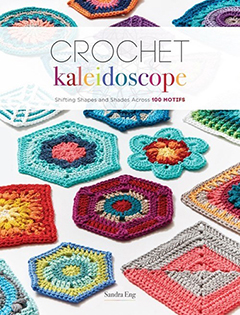
Similar Crochet Books and Related Resources
This book is included on our list of best crochet motif pattern books and our list of best granny square pattern books.
More Crochet Motif Pattern Books
- Seamless Crochet — Seamless Crochet is a book you should really consider buying along with Crochet Kaleidoscope. The two books are ideal companions. You can enjoy one without the other, but I truly think these two books enhance each other and are better together. If you want to crochet colorful projects, Seamless Crochet is likely to look rather boring as compared against Crochet Kaleidoscope — because most of the motifs and projects in the Seamless Crochet book are monochromatic. However, the book contains absolutely invaluable information about the topic of joining motifs as you go. If you don’t have a clear understanding of that technique already, Seamless Crochet is the best available resource I know of for learning it.
- Crochet Loom Blooms — If you’d like to make flower-shaped motifs using a flower loom and then crochet them together to make interesting projects like blankets, scarves and potholders, be sure to check out this book by bestselling author Haafner Linssen. It’s another book I highly recommend — I think you’ll LOVE IT!
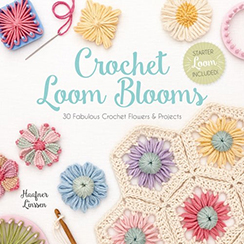
More Crochet Motif Patterns
More Crochet Flowers
- 6 Best Books on Crochet Flowers
- Mad Hatter Crochet Book Review: Patterns for Crocheting Colorful Flowers, Bags, Hats and More
More Crochet Granny Square Patterns
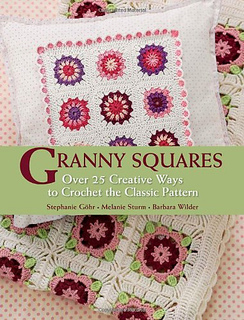
- Granny Square Crochet Tutorial for Total Beginners
- 3D Sunflower Granny Square Pattern
- Crochet Granny Square With Criss Cross Design
Posted By: Amy Solovay
This page was last updated on 11-3-2025.